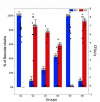Salmonella Excludes Salmonella in Poultry: Confirming an Old Paradigm Using Conventional and Barcode-Tagging Approaches
- PMID: 29868621
- PMCID: PMC5964308
- DOI: 10.3389/fvets.2018.00101
Salmonella Excludes Salmonella in Poultry: Confirming an Old Paradigm Using Conventional and Barcode-Tagging Approaches
Abstract
Salmonella is one of the major foodborne bacterial pathogens, and the consumption of contaminated chicken meats isa primary route of Salmonella transmission into human food chains. However, the mechanism of Salmonella transmission within the chicken flock is not fully understood, including competition among Salmonella strains during chicken infection. The purpose of the present study was to evaluate the competitive exclusion (CE) between different or same Salmonella species consecutively challenged through the oral route. Two different approaches were used to evaluate the CE effect, including tracking Salmonella colonization by wild-type strains with difference in natural antibiotic resistance or DNA barcode-tagged isogenic strains. When day-of-hatch chicks were administered by wild-type S. Typhimurium (ST) on day 1, followed by infection on day 2 by S. Enteritidis (SE) or vice versa, most of the birds were colonized only by the first strains administered (82% by ST or 83% by SE). When similar experiments were performed using two different isogenic barcode-tagged SE strains, Illumina sequencing analysis of the barcode region showed that the first barcode-tagged strains administered were dominant strains, ranging from 92 to 99% of the Salmonella recovered from ceca. These results provide quantitative evidence supporting the CE theory that oral administration of Salmonella will produce predominant inhibition over the subsequent colonization of ceca by the following administration one day later by different or same Salmonella species. We also showed that the use of barcode-tagged isogenic strains in combination with deep profiling of barcodes by Illumina sequencing can serve as a quantitative method for studying complex dynamics of Salmonella infection, transmission and colonization in poultry.
Keywords: Salmonella; barcode-tagged isogenic strain; competitive exclusion; intestinal colonization; poultry.
Figures


Similar articles
-
Quantitative Tracking of Salmonella Enteritidis Transmission Routes Using Barcode-Tagged Isogenic Strains in Chickens: Proof-of-Concept Study.Front Vet Sci. 2017 Feb 14;4:15. doi: 10.3389/fvets.2017.00015. eCollection 2017. Front Vet Sci. 2017. PMID: 28261587 Free PMC article.
-
Comparative study of the protective effect against Salmonella colonisation in newly hatched SPF chickens using live, attenuated Salmonella vaccine strains, wild-type Salmonella strains or a competitive exclusion product.Int J Food Microbiol. 1997 Apr 15;35(3):223-30. doi: 10.1016/s0168-1605(96)01236-6. Int J Food Microbiol. 1997. PMID: 9105931
-
Comparison of mucosal competitive exclusion and competitive exclusion treatment to reduce Salmonella and Campylobacter spp. colonization in broiler chickens.Poult Sci. 2001 Feb;80(2):156-60. doi: 10.1093/ps/80.2.156. Poult Sci. 2001. PMID: 11233003
-
Construction of DNA Barcode-Tagged Salmonella Strains.Methods Mol Biol. 2019;2016:141-150. doi: 10.1007/978-1-4939-9570-7_13. Methods Mol Biol. 2019. PMID: 31197716
-
Principles of ex ovo competitive exclusion and in ovo administration of Lactobacillus reuteri.Poult Sci. 1997 Jan;76(1):179-96. doi: 10.1093/ps/76.1.179. Poult Sci. 1997. PMID: 9037704 Review.
Cited by
-
Comparison of yeast-derived commercial feed additives on Salmonella Enteritidis survival and microbiota populations in rooster cecal in vitro incubations.PLoS One. 2023 Dec 14;18(12):e0295657. doi: 10.1371/journal.pone.0295657. eCollection 2023. PLoS One. 2023. PMID: 38096330 Free PMC article.
-
Examination of the Expression of Immunity Genes and Bacterial Profiles in the Caecum of Growing Chickens Infected with Salmonella Enteritidis and Fed a Phytobiotic.Animals (Basel). 2019 Aug 27;9(9):615. doi: 10.3390/ani9090615. Animals (Basel). 2019. PMID: 31462004 Free PMC article.
-
Molecular detection of Salmonella isolated from commercial chicken.Iran J Vet Res. 2022;23(1):39-45. doi: 10.22099/IJVR.2021.41301.5996. Iran J Vet Res. 2022. PMID: 35782360 Free PMC article.
-
Evaluation of pyroligneous acid as a therapeutic agent against Salmonella in a simulated gastrointestinal tract of poultry.Braz J Microbiol. 2020 Sep;51(3):1309-1316. doi: 10.1007/s42770-020-00294-1. Epub 2020 May 28. Braz J Microbiol. 2020. PMID: 32468399 Free PMC article.
-
Changes in the Microbial Composition of the Cecum and Histomorphometric Analysis of Its Epithelium in Broilers Fed with Feed Mixture Containing Fermented Rapeseed Meal.Microorganisms. 2021 Feb 12;9(2):360. doi: 10.3390/microorganisms9020360. Microorganisms. 2021. PMID: 33673092 Free PMC article.
References
LinkOut - more resources
Full Text Sources
Other Literature Sources

